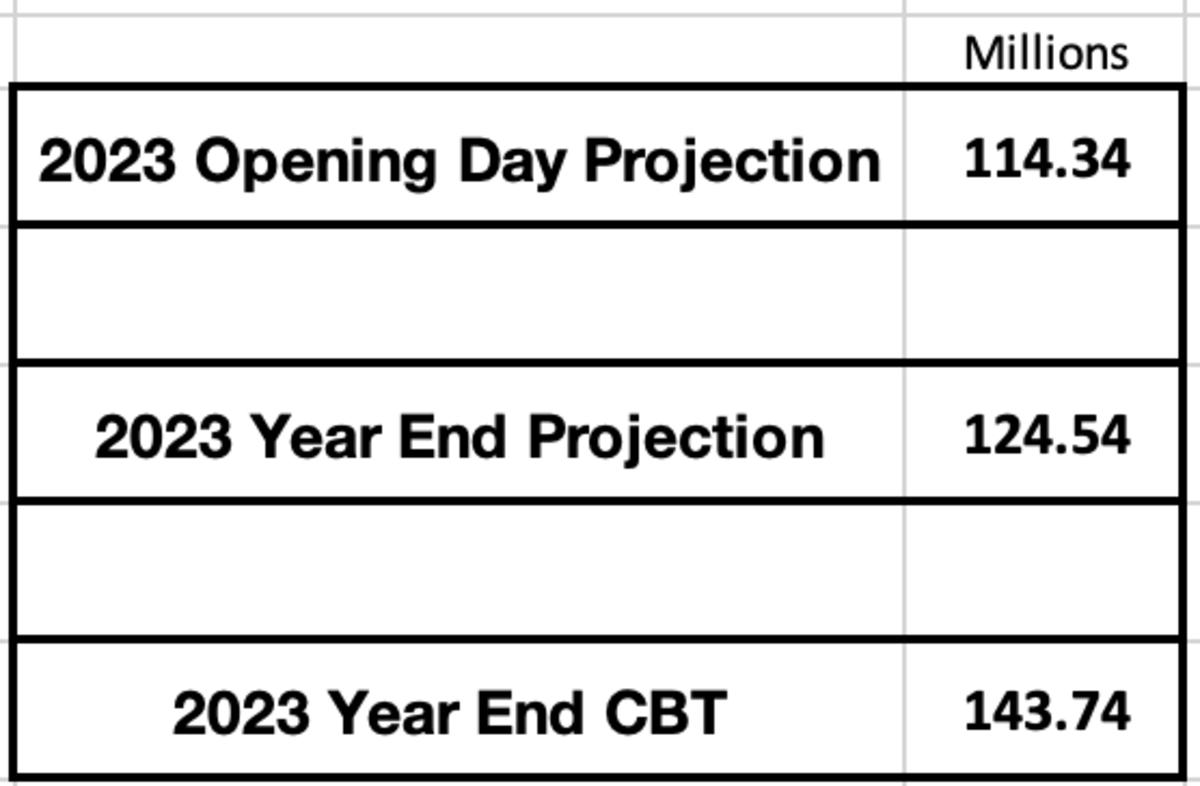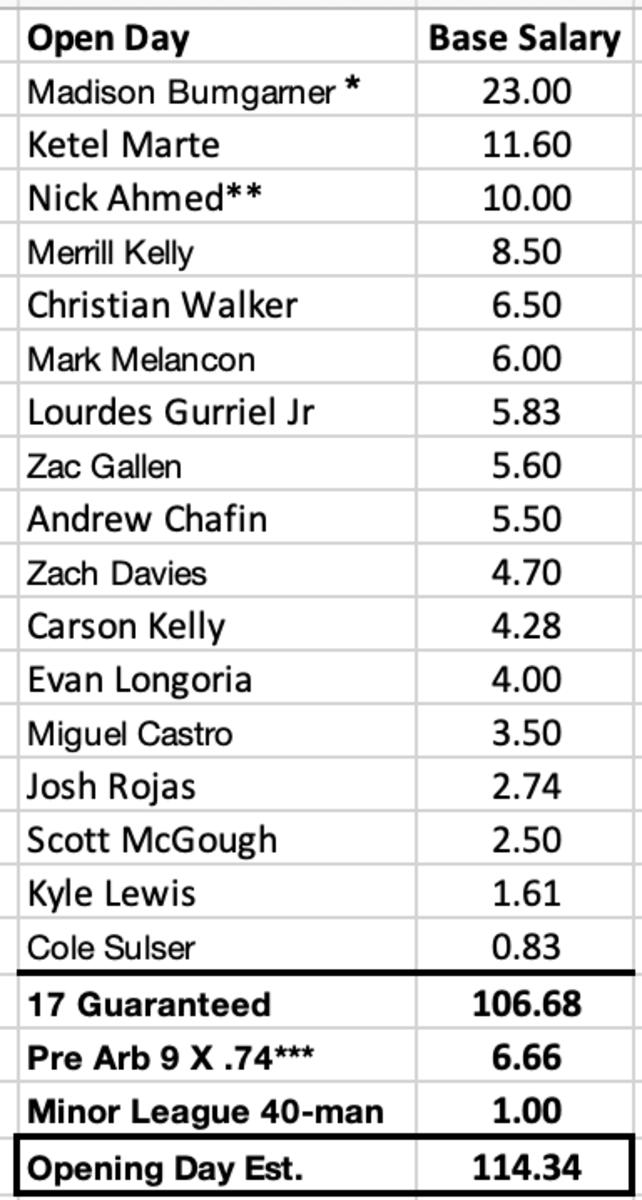Diamondbacks Increase Payroll More Than 20%

In 2019 and 2020 the Diamondbacks entered spring training with payrolls in excess of $123 million. However following the Pandemic shortened season of 2020 the team reduced opening day payroll to an estimated $90-95 million for each of 2021 and 2022. Heading into 2023 the D-backs now project to have an opening day payroll between $114-115 million, or an increase of 20%-25% from the previous two seasons.
There are several sites that track team payrolls, each providing valuable information in varying formats. They all come up with different totals too, although usually within a close range. Sites used for reference in this article include Cots Baseball Contracts, Roster Resource, and Spotrac.
Other than the fact that different sites have different formats and total numbers, the terminology used to describe payroll may be confusing for some. For simplicity, there are three major categories to consider. Opening Day Payroll, Year End Payroll, and Competitive Balance Tax Payroll. (CBT). Here are the total estimates for all three categories, with breakdowns and explanations below

Opening Day Payroll Estimate: $114.34M

* Madison Bumgarner: As reported at the time of his signing, from 2021-23, $5M annually is deferred without interest, to be paid in $5M installments each Nov. 1, 2025-27. However it is our understanding that per MLB rules any deferred salary must be funded separately in advance and therefore we include the deferred salary in the total. Due to the time value of money, plus no interest, the mechanism likely saves the Diamondbacks hundreds of thousands of dollars but is not calculated here
** Nick Ahmed: Typically signing bonuses are calculated as being spread evenly throughout the life of the contract, unless otherwise indicated. In Ahmed's case it's reported his $1.5M signing bonus was already paid in full, $1M on 4/1/20, $500,000 on 4/1/22. Hence there is a slight difference in what I show here and what you might see on other sites.
*** Pre arbitration players: There are 17 players with guaranteed contracts listed in the table above. That means a minimum of nine opening day roster positions will be filled by pre arbitration players. MLB league minimum is $720,000 for 2023. However most of the pre arb players have varying amounts of service time and will make anywhere from several thousand above minimum to as much as $60,000 above. I used $740,000 as an average estimate.
Minor League 40-Man Roster: Players in the minor leagues on the 40-man roster are guaranteed approximately $60,000. That works out to roughly $840K, but I rounded up to $1 million to account for additions to the 40-man roster over time.
Also of note, should non roster invitee Jeurys Familia make the roster he will be paid $1.5 million, with further incentives up to $500K. He would be replacing a $740K pre arb player, thus increasing payroll $760K, bringing it close to the high end estimate of $115 million mentioned at the top of the story.
Year End Estimate: $124.54
The above year end estimate is in keeping with what team president Derrick Hall told me at the beginning of the off season when he said he expected payroll to be "a little north" of $120 million. Teams must budget and account for other factors beyond opening day when setting payroll. Injury replacements and incentive bonuses are included in the year end estimate above.
Injury Replacements, $3.6 million: When a player on the active roster goes on the injured list he is still paid his major league salary and must be replaced for however many days he spends on the IL. From 2015-19 & 2022 (not including pandemic seasons of 2020-21) the average number of IL days for the D-backs was 826. Dividing that by 172 days of possible service in a season comes out to 4.80 years of player service time. Rounding up to 5.00 years x $720,000 league minimum salary equals $3.6 million.
Incentive Bonuses: $6.6 million: According to publicly available information six different players have performance and playing time bonuses that if maxed out would cost $11 million. I estimated 60% of those bonuses needing to be paid by year end. Players with incentives include Ketel Marte, Mark Melancon, Andrew Chafin, Zach Davies, Evan Longoria, and Miguel Castro. We will do a deeper dive on the incentive bonus structures in a separate article, as there are some interesting things to learn about both the player and organization's thinking through that analysis.
Buyers or Sellers? Teams can add or subtract salary during the season via trades. More often than not the D-backs have been sellers up through the trade deadline, but occasionally are in contention and will add payroll. This is completely unpredictable however, so no effort to account for this has been included.
Competitive Balance Tax Payroll: 143.74M
A team's "CBT" payroll is comprised of a complicated set of calculations in order to determine whether they should be subject to the "luxury tax". You can read the details about that here. The Diamondbacks have never been subject to the luxury tax and are highly unlikely to under current ownership. But if you should happen to come across the term CBT payroll elsewhere there are a few basic points to know:
Average Annual: A player on a multi year contract has his salary calculated using the average annual instead of the current year amount used in the "opening day" numbers one might more commonly see.
Player benefits include insurance and pension fund contributions, which are estimated to be approximately $17 million per team and are included in CBT calculations
Pre Arb bonus pool: Each team must make a payment of $1.667 million into a $50M pre-arbitration bonus pool. This is included in CBT calculations
Option buyouts: Per a team official, buyouts of the next season's option are paid to the player at the end of the current season, but for CBT purposes that money is part of the following year's CBT calculation. The Dbacks had $500K of option buy outs paid last November ($250K each to Ian Kennedy and Zach Davies) that are included in 2023 CBT. There are potentially $3.25M in options to be paid out at the end of 2023 for Mark Melancon, Andrew Chafin and Zach Davies, but those are not yet included in any of the calculations above.
Payroll as percentage of revenue: This is a key metric that is often tracked and referenced. It is a key feature of Collective Bargaining discussions. The league average used to be around 56-57%. When that number dipped into the low 50's it precipitated much of the labor unrest seen in recent years. From 2015-2017 the Diamondbacks only spent about 45% of revenue on player compensation. That increased to 55% , or about league average for 2018-2019. 2020 and 2021 are skewed well over 60-70% due to big losses from the Pandemic and 2022 numbers are not yet available.
